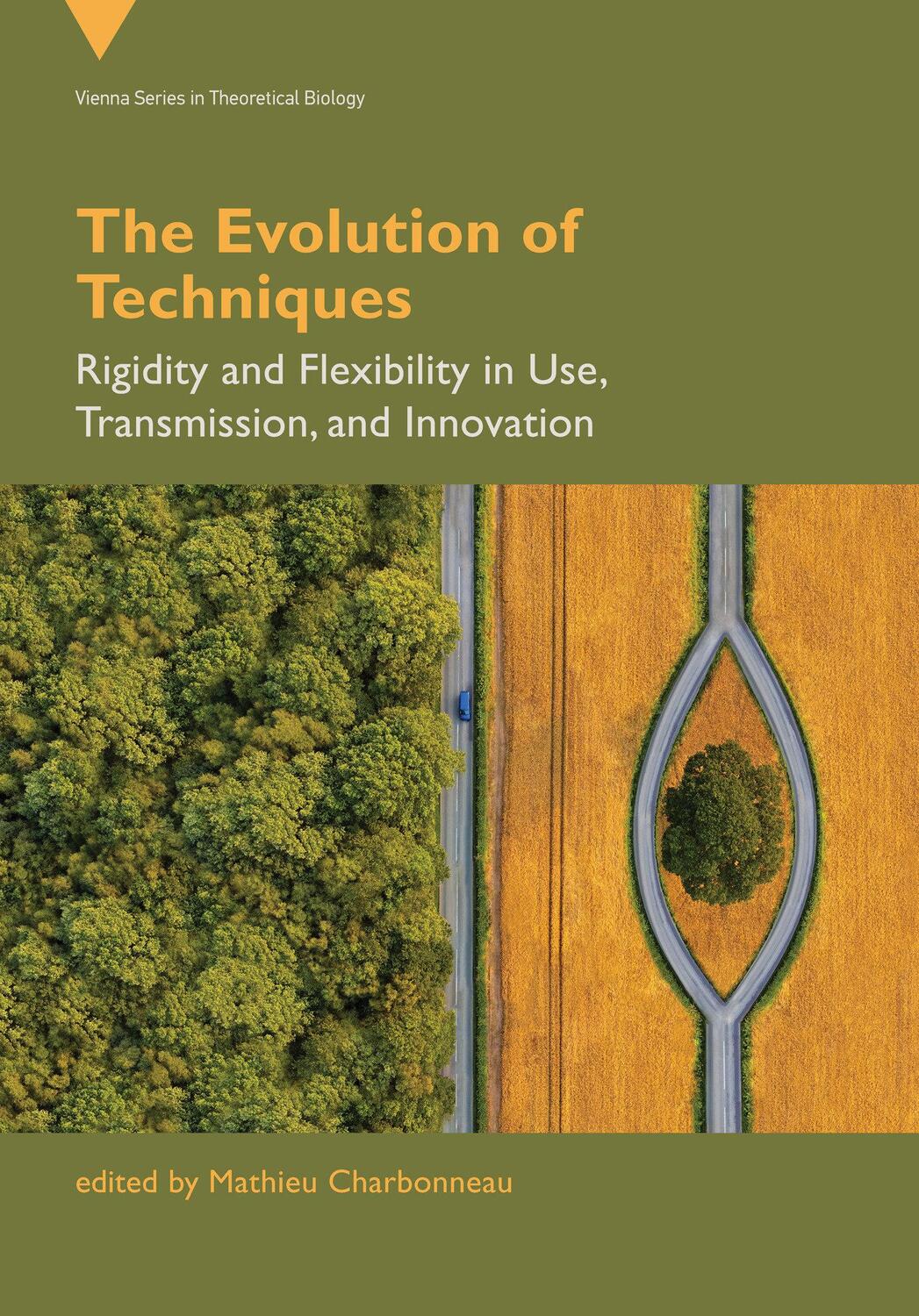Dekorationsartikel gehören nicht zum Leistungsumfang.
Sprache:
Englisch
78,50 €*
Versandkostenfrei per Post / DHL
Aktuell nicht verfügbar
Kategorien:
Beschreibung
A novel, interdisciplinary exploration of the relative contributions of rigidity and flexibility in the adoption, maintenance, and evolution of technical traditions.
Techniques can either be used in rigid, stereotypical ways or in flexibly adaptive ways, or in some combination of the two. The Evolution of Techniques, edited by Mathieu Charbonneau, addresses the impacts of both flexibility and rigidity on how techniques are used, transformed, and reconstructed, at varying social and temporal scales. The multidisciplinary contributors demonstrate the important role of the varied learning contexts and social configurations involved in the transmission, use, and evolution of techniques. They explore the diversity of cognitive, behavioral, sociocultural, and ecological mechanisms that promote and constrain technical flexibility and rigidity, proposing a deeper picture of the enablers of, and obstacles to, technical transmission and change.
In line with the extended evolutionary synthesis, the book proposes a more inclusive and materially grounded conception of technical evolution in terms of promiscuous, dynamic, and multidirectional causal processes. Offering new evidence and novel theoretical perspectives, the contributors deploy a diversity of methods, including ethnographies, field and laboratory experiments, cladistics and phylogenetic tree building, historiography, and philosophical analysis. Examples of the wide range of topics covered include field experiments with potters from five cultures, stability and change in Paleolithic toolmaking, why children lack flexibility when making tools, and cultural techniques in nonhuman animals.
The volume’s three thematic sections are:
· Timescales of technical rigidity and flexibility
· Rigid copying to flexible reconstruction
· Exogenous factors of technical rigidity and flexibility
The volume closes with a discussion by philosopher Kim Sterelny.
Contributors
Rita Astuti, Adam Howell Boyette, Blandine Bril, Josep Call, Mathieu Charbonneau, Arianna Curioni, Nicola Cutting, Bert De Munck, György Gergely, Anne-Lise Goujon, Ildikó Király, Catherine Lara, Sébastien Manem, Luke McEllin, Helena Miton, Giulio Ongaro, Sarah Pope-Caldwell, Valentine Roux, Manon Schweinfurth, Dan Sperber, Kim Sterelny, Dietrich Stout, James W. A. Strachan, Sadie Tenpas
Techniques can either be used in rigid, stereotypical ways or in flexibly adaptive ways, or in some combination of the two. The Evolution of Techniques, edited by Mathieu Charbonneau, addresses the impacts of both flexibility and rigidity on how techniques are used, transformed, and reconstructed, at varying social and temporal scales. The multidisciplinary contributors demonstrate the important role of the varied learning contexts and social configurations involved in the transmission, use, and evolution of techniques. They explore the diversity of cognitive, behavioral, sociocultural, and ecological mechanisms that promote and constrain technical flexibility and rigidity, proposing a deeper picture of the enablers of, and obstacles to, technical transmission and change.
In line with the extended evolutionary synthesis, the book proposes a more inclusive and materially grounded conception of technical evolution in terms of promiscuous, dynamic, and multidirectional causal processes. Offering new evidence and novel theoretical perspectives, the contributors deploy a diversity of methods, including ethnographies, field and laboratory experiments, cladistics and phylogenetic tree building, historiography, and philosophical analysis. Examples of the wide range of topics covered include field experiments with potters from five cultures, stability and change in Paleolithic toolmaking, why children lack flexibility when making tools, and cultural techniques in nonhuman animals.
The volume’s three thematic sections are:
· Timescales of technical rigidity and flexibility
· Rigid copying to flexible reconstruction
· Exogenous factors of technical rigidity and flexibility
The volume closes with a discussion by philosopher Kim Sterelny.
Contributors
Rita Astuti, Adam Howell Boyette, Blandine Bril, Josep Call, Mathieu Charbonneau, Arianna Curioni, Nicola Cutting, Bert De Munck, György Gergely, Anne-Lise Goujon, Ildikó Király, Catherine Lara, Sébastien Manem, Luke McEllin, Helena Miton, Giulio Ongaro, Sarah Pope-Caldwell, Valentine Roux, Manon Schweinfurth, Dan Sperber, Kim Sterelny, Dietrich Stout, James W. A. Strachan, Sadie Tenpas
A novel, interdisciplinary exploration of the relative contributions of rigidity and flexibility in the adoption, maintenance, and evolution of technical traditions.
Techniques can either be used in rigid, stereotypical ways or in flexibly adaptive ways, or in some combination of the two. The Evolution of Techniques, edited by Mathieu Charbonneau, addresses the impacts of both flexibility and rigidity on how techniques are used, transformed, and reconstructed, at varying social and temporal scales. The multidisciplinary contributors demonstrate the important role of the varied learning contexts and social configurations involved in the transmission, use, and evolution of techniques. They explore the diversity of cognitive, behavioral, sociocultural, and ecological mechanisms that promote and constrain technical flexibility and rigidity, proposing a deeper picture of the enablers of, and obstacles to, technical transmission and change.
In line with the extended evolutionary synthesis, the book proposes a more inclusive and materially grounded conception of technical evolution in terms of promiscuous, dynamic, and multidirectional causal processes. Offering new evidence and novel theoretical perspectives, the contributors deploy a diversity of methods, including ethnographies, field and laboratory experiments, cladistics and phylogenetic tree building, historiography, and philosophical analysis. Examples of the wide range of topics covered include field experiments with potters from five cultures, stability and change in Paleolithic toolmaking, why children lack flexibility when making tools, and cultural techniques in nonhuman animals.
The volume’s three thematic sections are:
· Timescales of technical rigidity and flexibility
· Rigid copying to flexible reconstruction
· Exogenous factors of technical rigidity and flexibility
The volume closes with a discussion by philosopher Kim Sterelny.
Contributors
Rita Astuti, Adam Howell Boyette, Blandine Bril, Josep Call, Mathieu Charbonneau, Arianna Curioni, Nicola Cutting, Bert De Munck, György Gergely, Anne-Lise Goujon, Ildikó Király, Catherine Lara, Sébastien Manem, Luke McEllin, Helena Miton, Giulio Ongaro, Sarah Pope-Caldwell, Valentine Roux, Manon Schweinfurth, Dan Sperber, Kim Sterelny, Dietrich Stout, James W. A. Strachan, Sadie Tenpas
Techniques can either be used in rigid, stereotypical ways or in flexibly adaptive ways, or in some combination of the two. The Evolution of Techniques, edited by Mathieu Charbonneau, addresses the impacts of both flexibility and rigidity on how techniques are used, transformed, and reconstructed, at varying social and temporal scales. The multidisciplinary contributors demonstrate the important role of the varied learning contexts and social configurations involved in the transmission, use, and evolution of techniques. They explore the diversity of cognitive, behavioral, sociocultural, and ecological mechanisms that promote and constrain technical flexibility and rigidity, proposing a deeper picture of the enablers of, and obstacles to, technical transmission and change.
In line with the extended evolutionary synthesis, the book proposes a more inclusive and materially grounded conception of technical evolution in terms of promiscuous, dynamic, and multidirectional causal processes. Offering new evidence and novel theoretical perspectives, the contributors deploy a diversity of methods, including ethnographies, field and laboratory experiments, cladistics and phylogenetic tree building, historiography, and philosophical analysis. Examples of the wide range of topics covered include field experiments with potters from five cultures, stability and change in Paleolithic toolmaking, why children lack flexibility when making tools, and cultural techniques in nonhuman animals.
The volume’s three thematic sections are:
· Timescales of technical rigidity and flexibility
· Rigid copying to flexible reconstruction
· Exogenous factors of technical rigidity and flexibility
The volume closes with a discussion by philosopher Kim Sterelny.
Contributors
Rita Astuti, Adam Howell Boyette, Blandine Bril, Josep Call, Mathieu Charbonneau, Arianna Curioni, Nicola Cutting, Bert De Munck, György Gergely, Anne-Lise Goujon, Ildikó Király, Catherine Lara, Sébastien Manem, Luke McEllin, Helena Miton, Giulio Ongaro, Sarah Pope-Caldwell, Valentine Roux, Manon Schweinfurth, Dan Sperber, Kim Sterelny, Dietrich Stout, James W. A. Strachan, Sadie Tenpas
Über den Autor
edited by Mathieu Charbonneau
Inhaltsverzeichnis
Series Foreword vii
Preface and Acknowledgments: Mathieu Charbonneau ix
Introduction: Mathieu Charbonneau and Dan Sperber xi
I TIMESCALES OF TECHNICAL RIGIDITY AND FLEXIBILITY
1 Adaptive Be havior within Technological Stability: Field Experiments with Potters from Five Cultures 3
2 Innovation and Social Identity in Madagascar 27
3 Apprenticeship, Flexibility, and Rigidity: A Long-Term Perspective 37
4 When Rigidity Invents Flexibility to Preserve Some Stability in the Transmission of Pottery-Making during the European Middle Bronze Age 55
II FROM RIGID COPYING TO FLEXIBLE RECONSTRUCTION
5 Relevance-Based Emulation as a Prerequisite for Technical Innovation 81
6 Flexible Social Learning of Technical Skills: The Case of Action Coordination 107
7 Playing with Knives: Children’s Learning, Cultural Niche Construction, and the Evolution of Technical Flexibility 121
8 Stability and Change in Paleolithic Toolmaking 139
III EXOGENOUS FACTORS OF TECHNICAL RIGIDITY AND FLEXIBILITY
9 How Variability, Predictability, and Harshness Shape Cognitive Flexibility 161
10 The Cultural Identity of Techniques: Rigidity and Flexibility among the Akha of Highland Laos 179
11 Why Do Children Lack Flexibility When Making Tools? The Role of Social Learning in Innovation 195
12 A Tactful Tradition: The Role of Flexibility and Rigidity in Horse Riding and Dressage 215
13 Exploring Cultural Techniques in Nonhuman Animals: How Are Flexibility and Rigidity Expressed at the Individual, Group, and Population Level? 235
Discussion: The Cumulative Culture Mosaic 253
Contributors 271
Index 273
Preface and Acknowledgments: Mathieu Charbonneau ix
Introduction: Mathieu Charbonneau and Dan Sperber xi
I TIMESCALES OF TECHNICAL RIGIDITY AND FLEXIBILITY
1 Adaptive Be havior within Technological Stability: Field Experiments with Potters from Five Cultures 3
2 Innovation and Social Identity in Madagascar 27
3 Apprenticeship, Flexibility, and Rigidity: A Long-Term Perspective 37
4 When Rigidity Invents Flexibility to Preserve Some Stability in the Transmission of Pottery-Making during the European Middle Bronze Age 55
II FROM RIGID COPYING TO FLEXIBLE RECONSTRUCTION
5 Relevance-Based Emulation as a Prerequisite for Technical Innovation 81
6 Flexible Social Learning of Technical Skills: The Case of Action Coordination 107
7 Playing with Knives: Children’s Learning, Cultural Niche Construction, and the Evolution of Technical Flexibility 121
8 Stability and Change in Paleolithic Toolmaking 139
III EXOGENOUS FACTORS OF TECHNICAL RIGIDITY AND FLEXIBILITY
9 How Variability, Predictability, and Harshness Shape Cognitive Flexibility 161
10 The Cultural Identity of Techniques: Rigidity and Flexibility among the Akha of Highland Laos 179
11 Why Do Children Lack Flexibility When Making Tools? The Role of Social Learning in Innovation 195
12 A Tactful Tradition: The Role of Flexibility and Rigidity in Horse Riding and Dressage 215
13 Exploring Cultural Techniques in Nonhuman Animals: How Are Flexibility and Rigidity Expressed at the Individual, Group, and Population Level? 235
Discussion: The Cumulative Culture Mosaic 253
Contributors 271
Index 273
Details
| Erscheinungsjahr: | 2024 |
|---|---|
| Fachbereich: | Allgemeines |
| Rubrik: | Sozialwissenschaften |
| Medium: | Taschenbuch |
| Seiten: | 320 |
| Inhalt: | Einband - flex.(Paperback) |
| ISBN-13: | 9780262547802 |
| ISBN-10: | 0262547805 |
| Sprache: | Englisch |
| Einband: | Kartoniert / Broschiert |
| Autor: | Charbonneau, Mathieu |
| Redaktion: | Mathieu Charbonneau |
| Hersteller: | MIT Press Ltd |
| Maße: | 178 x 254 x 26 mm |
| Von/Mit: | Mathieu Charbonneau |
| Erscheinungsdatum: | 19.03.2024 |
| Gewicht: | 0,484 kg |
Über den Autor
edited by Mathieu Charbonneau
Inhaltsverzeichnis
Series Foreword vii
Preface and Acknowledgments: Mathieu Charbonneau ix
Introduction: Mathieu Charbonneau and Dan Sperber xi
I TIMESCALES OF TECHNICAL RIGIDITY AND FLEXIBILITY
1 Adaptive Be havior within Technological Stability: Field Experiments with Potters from Five Cultures 3
2 Innovation and Social Identity in Madagascar 27
3 Apprenticeship, Flexibility, and Rigidity: A Long-Term Perspective 37
4 When Rigidity Invents Flexibility to Preserve Some Stability in the Transmission of Pottery-Making during the European Middle Bronze Age 55
II FROM RIGID COPYING TO FLEXIBLE RECONSTRUCTION
5 Relevance-Based Emulation as a Prerequisite for Technical Innovation 81
6 Flexible Social Learning of Technical Skills: The Case of Action Coordination 107
7 Playing with Knives: Children’s Learning, Cultural Niche Construction, and the Evolution of Technical Flexibility 121
8 Stability and Change in Paleolithic Toolmaking 139
III EXOGENOUS FACTORS OF TECHNICAL RIGIDITY AND FLEXIBILITY
9 How Variability, Predictability, and Harshness Shape Cognitive Flexibility 161
10 The Cultural Identity of Techniques: Rigidity and Flexibility among the Akha of Highland Laos 179
11 Why Do Children Lack Flexibility When Making Tools? The Role of Social Learning in Innovation 195
12 A Tactful Tradition: The Role of Flexibility and Rigidity in Horse Riding and Dressage 215
13 Exploring Cultural Techniques in Nonhuman Animals: How Are Flexibility and Rigidity Expressed at the Individual, Group, and Population Level? 235
Discussion: The Cumulative Culture Mosaic 253
Contributors 271
Index 273
Preface and Acknowledgments: Mathieu Charbonneau ix
Introduction: Mathieu Charbonneau and Dan Sperber xi
I TIMESCALES OF TECHNICAL RIGIDITY AND FLEXIBILITY
1 Adaptive Be havior within Technological Stability: Field Experiments with Potters from Five Cultures 3
2 Innovation and Social Identity in Madagascar 27
3 Apprenticeship, Flexibility, and Rigidity: A Long-Term Perspective 37
4 When Rigidity Invents Flexibility to Preserve Some Stability in the Transmission of Pottery-Making during the European Middle Bronze Age 55
II FROM RIGID COPYING TO FLEXIBLE RECONSTRUCTION
5 Relevance-Based Emulation as a Prerequisite for Technical Innovation 81
6 Flexible Social Learning of Technical Skills: The Case of Action Coordination 107
7 Playing with Knives: Children’s Learning, Cultural Niche Construction, and the Evolution of Technical Flexibility 121
8 Stability and Change in Paleolithic Toolmaking 139
III EXOGENOUS FACTORS OF TECHNICAL RIGIDITY AND FLEXIBILITY
9 How Variability, Predictability, and Harshness Shape Cognitive Flexibility 161
10 The Cultural Identity of Techniques: Rigidity and Flexibility among the Akha of Highland Laos 179
11 Why Do Children Lack Flexibility When Making Tools? The Role of Social Learning in Innovation 195
12 A Tactful Tradition: The Role of Flexibility and Rigidity in Horse Riding and Dressage 215
13 Exploring Cultural Techniques in Nonhuman Animals: How Are Flexibility and Rigidity Expressed at the Individual, Group, and Population Level? 235
Discussion: The Cumulative Culture Mosaic 253
Contributors 271
Index 273
Details
| Erscheinungsjahr: | 2024 |
|---|---|
| Fachbereich: | Allgemeines |
| Rubrik: | Sozialwissenschaften |
| Medium: | Taschenbuch |
| Seiten: | 320 |
| Inhalt: | Einband - flex.(Paperback) |
| ISBN-13: | 9780262547802 |
| ISBN-10: | 0262547805 |
| Sprache: | Englisch |
| Einband: | Kartoniert / Broschiert |
| Autor: | Charbonneau, Mathieu |
| Redaktion: | Mathieu Charbonneau |
| Hersteller: | MIT Press Ltd |
| Maße: | 178 x 254 x 26 mm |
| Von/Mit: | Mathieu Charbonneau |
| Erscheinungsdatum: | 19.03.2024 |
| Gewicht: | 0,484 kg |
Warnhinweis











